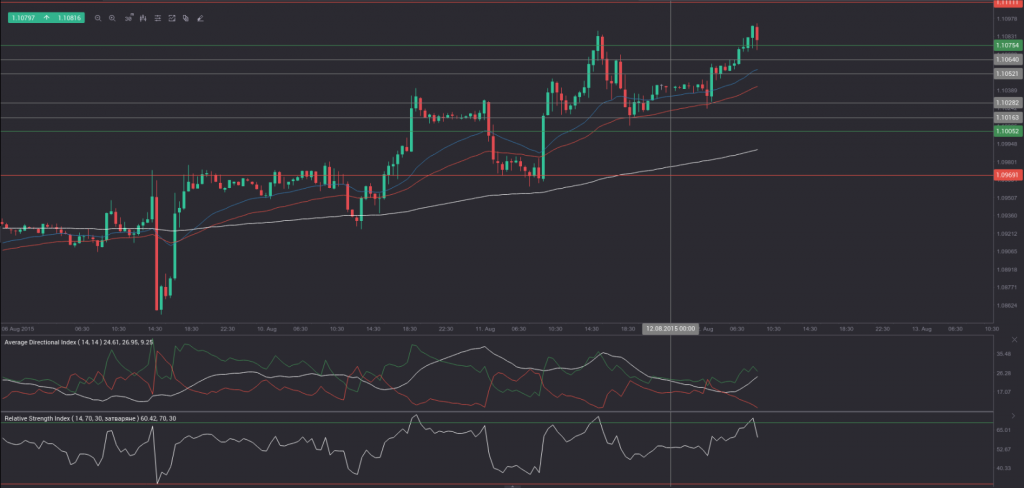Yesterday’s trade saw EUR/USD within the range of 1.0959-1.1088. The pair closed at 1.1040, soaring 0.19% on a daily basis and extending gains from Monday. The daily high has also been the highest level since July 31st, when the cross registered a high of 1.1114.
At 6:42 GMT today EUR/USD was up 0.43% for the day to trade at 1.1089. The pair is set to test the upper range breakout level (R4), as it touched a daily high at 1.1095 at 6:43 GMT. It is now the new highest level since July 31st.
Today the cross may be influenced by a number of macroeconomic reports as listed below.
Fundamentals
Euro area
Italian Balance of Trade
The surplus on Italys trade balance probably narrowed to EUR 3.980 billion in June, according to market expectations, from a surplus figure of EUR 4.184 billion in May. The latter has been the most significant surplus since December 2014, when a figure of EUR 5.756 billion was reported. It also represented a 12.36% increase compared to May 2014 surplus of EUR 3.72 billion.
Total exports surged at an annualized rate of 2% to reach EUR 35.39 billion in May, as shipments of energy products rose 16.9%, while sales of consumer goods went up 5.1%. Exports of capital goods, on the other hand, dropped 1.3%. The largest rates of increase in sales were observed towards Belgium (14.8%), Spain (13.4%), the United Kingdom (10.8%), Czech Republic (10%) and Turkey (9.4%).
Total imports grew at an annualized rate of 0.8% to reach EUR 31.21 billion in May, supported by a 9.5% surge in purchases of capital goods and a 5.1% surge in purchases of consumer goods.
The trade balance, as an indicator, measures the difference in value between the country’s exported and imported goods during the reported period. It reflects the net export of goods, or one of the components to form the Gross Domestic Product. Generally, exports reflect how strong economic growth is, while imports indicate the strength of domestic demand. In case Italian trade surplus narrowed more than anticipated in June, this might have a limited bearish effect on the single currency. The National Institute of Statistics (Istat) is to release the official trade data at 8:00 GMT.
Euro area industrial output
The seasonally adjusted index of industrial production in the Euro area probably dropped 0.2% in June compared to a month ago, extending the decline registered in May (-0.4%). The latter has been the sharpest monthly decrease in output since August 2014, when industrial production shrank 1.4%.
Annualized output probably increased at a pace of 1.5% in June, according to market expectations. If so, this would be the seventh consecutive month, when annual output grew. In May industrial production expanded 1.6% year-on-year, as production of durable consumer goods rose 4.8%, production of capital goods went up 4.1% and production of intermediate goods was 2.2% higher. At the same time, production of non-durable consumer goods was 0.5% lower in May, while production of energy shrank 4.2%.
In May, the highest increases in industrial output were reported for Malta (+9.5% year-on-year), Latvia (+6.5%) and Hungary (+6.2%), while the most considerable decreases were observed in the Netherlands (-7.4%), Finland (-5.1%) and Ireland (-5.0%).
The index, reflecting the business cycle, measures the change in overall inflation-adjusted value of output in sectors such as manufacturing, mining and utilities. In case annualized industrial output expanded more than anticipated, this would support demand for the euro, as this implies a higher probability of inflationary pressure occurring. Eurostat is to publish the official data at 9:00 GMT.
United States
Job Openings
The number of job openings in the United States probably dropped a second month in a row to reach 5.300 million in June from 5.363 million in May. If so, Junes figure would be the lowest one since March, when 4.994 million job openings were reported. This indicator refers to all positions that are open, but not filled on the last business day of the month. Job openings are part of the Job Openings and Labor Turnover Survey (JOLTS), which gathers data from about 16 400 non-farm establishments including retailers and manufacturers, as well as federal, state, and local government entities in the 50 states and the District of Columbia. The survey assesses the unmet demand for labor in the labor market. Lower-than-projected number of openings will usually mount selling pressure on the US dollar. The Bureau of Labor Statistics is to release the official data at 15:00 GMT.
Monthly Budget Statement
The United States probably recorded a government budget deficit of USD 113.5 billion in July, according to market expectations, after a surplus of USD 51.8 billion during the previous month. If so, the July deficit would be the most considerable one since February, when a gap of USD 192 billion was reported. The June surplus represented a 27% decrease compared to the same month a year ago. In June total receipts were at the amount of USD 342.9 billion, or up 6% compared to June 2014, while total outlays amounted to USD 291.2 billion, or a 15% increase from a year earlier. In June, the government usually generates a surplus, due to the collection of corporate and individual taxes at end of the month.
In the 12 months to June the budget deficit was at the amount of USD 431 billion, which represented a drop of almost 20% compared to the preceding 12 months, according to the report by the US Treasury. It has been the second lowest 12-month deficit figure since August 2008.
A larger-than-projected budget deficit would have a moderate bearish effect on the greenback. The Financial Management Service is to publish the official figure at 18:00 GMT.
Bond Yield Spread
The yield on German 2-year government bonds went as high as -0.265% on August 11th, after which it slid to -0.278% at the close to lose 0.009 percentage point on a daily basis, while marking a fourth consecutive trading day of decline.
The yield on US 2-year government bonds climbed as high as 0.729% on August 11th, after which it fell to 0.681% at the close to lose 4.8 basis points (0.048 percentage point) for the day. It has been the first drop in the past three trading days.
The spread between 2-year US and 2-year German bond yields, which reflects the flow of funds in a short term, shrank to 0.959% on August 11th from 0.998% during the prior day. The August 11th spread has been the lowest one since August 6th, when the difference was 0.951%.
Meanwhile, the yield on German 10-year government bonds soared as high as 0.705% on August 11th, after which it slid to 0.634% at the close to lose 6.4 basis points (0.064 percentage point) compared to August 10th.
The yield on US 10-year government bonds climbed as high as 2.232% on August 11th, after which it slipped to 2.150% at the close to lose 8.2 basis points (0.082 percentage point) on a daily basis.
The spread between 10-year US and 10-year German bond yields narrowed to 1.516% on August 11th from 1.534% during the prior day. The August 11th yield difference has been the lowest one since August 7th, when the spread was 1.508%.
Daily and Weekly Pivot Levels
By employing the Camarilla calculation method, the daily pivot levels for EUR/USD are presented as follows:
R1 – 1.1052
R2 – 1.1064
R3 (range resistance – green on the 30-minute chart) – 1.1075
R4 (range breakout – red on the 30-minute chart) – 1.1111
S1 – 1.1028
S2 – 1.1016
S3 (range support – green on the 30-minute chart) – 1.1005
S4 (range breakout – red on the 30-minute chart) – 1.0969
By using the traditional method of calculation, the weekly pivot levels for EUR/USD are presented as follows:
Central Pivot Point – 1.0938
R1 – 1.1029
R2 – 1.1089
R3 – 1.1180
S1 – 1.0878
S2 – 1.0787
S3 – 1.0727






